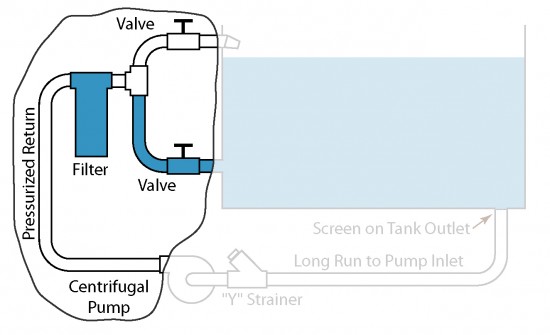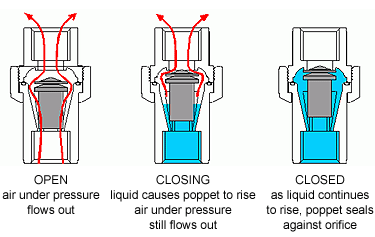So, the goal is to get the air out of the system so that the pump can operate properly. In the preceding blog I explained what factors might keep air from escaping from the inlet side of the pump. It would, then, be a logical question to ask, “Why doesn’t the air just go out the other way?” After all, the pump does have both an inlet and an outlet!

As is the case on the inlet side of the pump, there are obstructions to the release of air on the outlet side as well. Just as is the case on the inlet side of the pump, air trapped in the high points of long plumbing runs won’t exit of its own accord. The pressure and flow required far exceeds the capacity of a centrifugal pump in an “air locked” condition.
Valves that are closed are, of course, barriers to the escape of air. This is a no-brainer in the case of a simple gate or globe valve. One possible solution is to open them during system refilling. Some valves, however, and especially solenoid valves have very complex internal geometry which can impede the flow of air. Some, in fact, only have a very small “pilot” hole through which liquid must pass to cause the larger valve port to open. The surface tension of liquid is often sufficient to prevent air from exiting through this pilot hole. Switching on a solenoid valve does not always (and I can safely say seldom) provide a sufficiently large escape path for trapped air to eliminate an air lock.
The other, and often unexpected, barrier to air escape on the outlet side of the pump is the filter. We accept that filters cause a pressure drop when liquid flows through them, but the fact is that most filter media is almost impermeable to air when it is wet – especially at the pressure that air is able to exert by buoyancy alone. Consider a filter as a total obstruction to the flow of air in the case of an air lock. This is why tactics like directing a flow of liquid under pressure directly into the pump inlet frequently fail to eliminate an air lock. The trapped air has to go someplace!
So, you know you have an air lock when the pump is operating (centrifugal pump) and there is no liquid flow. What to do? I find it helpful to think the plumbing system through looking for the obstructions to airflow described in these blogs. Remember, it is AIR, not liquid that is the problem! There is not always a simple solution. Design engineers can help by designing plumbing configurations that will not produce air locks but the required changes may not be possible after the fact. One possible solution is to, after determining where an air lock occurs repeatedly, add a “bleed” valve that can be used subsequently to quickly and easily release trapped air. On the outlet side of the pump (where there is pressure) an automated bleed valve similar to those used in residential hot water heating systems may be effective.

Essentially, this device remains “open” when full of air but closes once liquid is present. These devices, of course, must be mounted vertically to operate. Unfortunately, a similar device can not be used on the inlet side of the pump. This is because the suction of the pump will cause the valve to open allowing air to mix with the liquid flowing to the pump thereby adding to the possibility of an air lock developing under operating conditions.
The purpose of this series of blogs has been to make the reader aware of “air locks,” their cause and some possible solutions. Not recognizing and correcting an air lock in a system has led to the destruction of many pumps which depend on liquid flow to cool and lubricate the pump seal.
– FJF –



 English
English Spanish
Spanish Chinese
Chinese Canada
Canada Mexico
Mexico United Kingdom
United Kingdom



